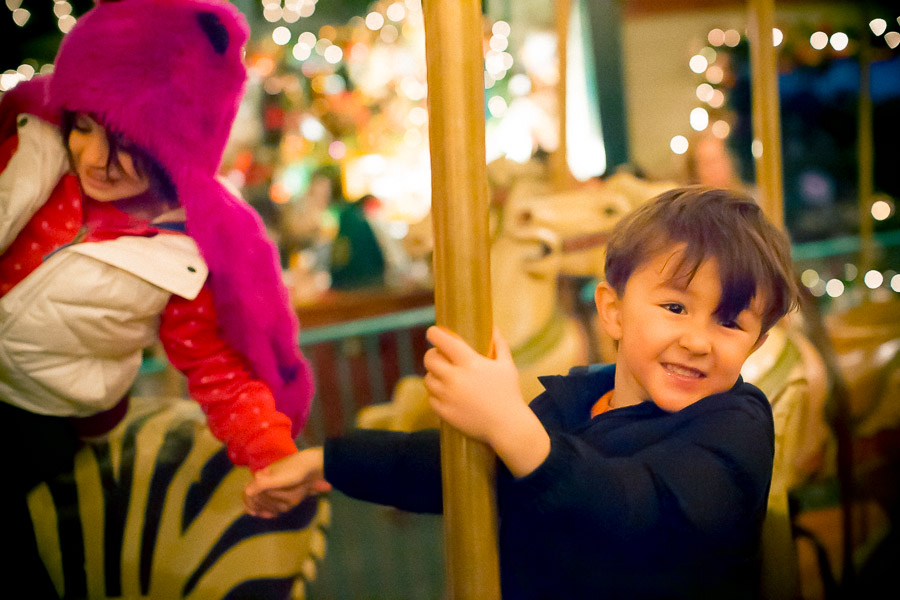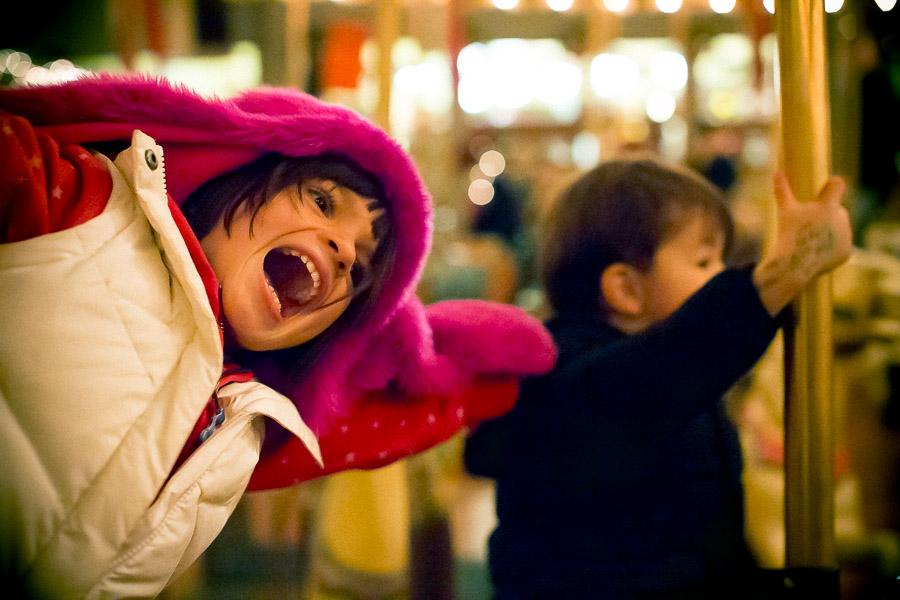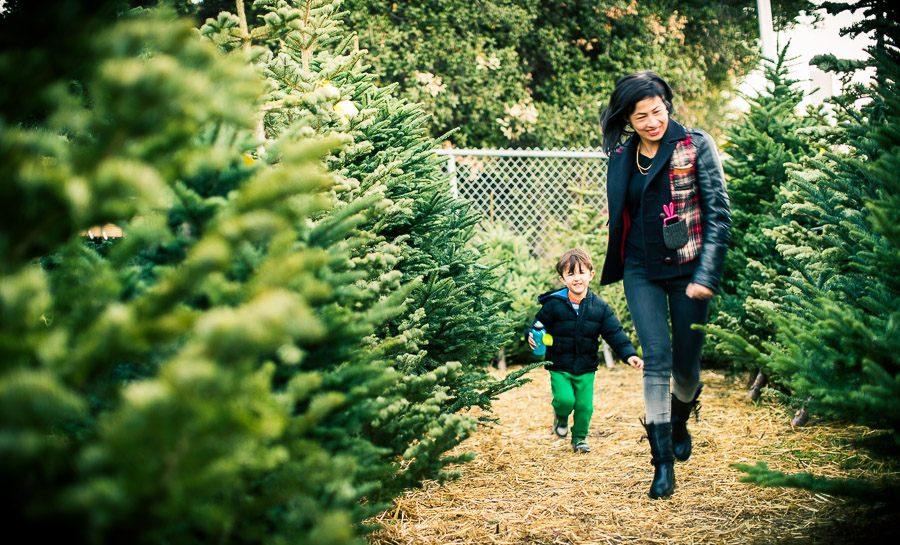How to Take Good Photos for Under $1,000
 Wednesday, December 11, 2013 at 10:34AM
Wednesday, December 11, 2013 at 10:34AM 
Yesterday was a big family Christmas-type day. We picked out our tree, hung the lights, and visited Santa. Usually we wait in line to see Santa, but on this day he was taking a break, helping to run the merry-go-round. My son and his friend were finishing up their ride when they spotted him. He came over to do the Santa thing. And suddenly I realized that Santa was happening right now, whether I was ready or not.
But I was ready.
I posted the photos that evening, and a few friends asked, in a flattering and kind way, how I always get such nice shots. And the answer is not a new one, but as I replied, I realized that it is a valuable one to repeat.
Christmas is coming. Here’s how to take some good photos.
Buy a DSLR
Step one is to put your phone away. Step two is to, for the time being, ignore all the excitement about mirrorless cameras. There are some great ones, but this is my advice, and I use an SLR.
Buy literally any DSLR. The cheapest ones you can get these days are crazy good. There’s the Canon Rebel line, and the Nikon D3200. Heck, buy a used one from a couple of years ago.
Buy the body only. The kit lens that comes with these inexpensive SLRs is not worth the plastic it’s stamped out of. If your inexpensive DSLR is not available without a lens, buy it and literally throw away the lens. Into a landfill. Directly onto endangered waterfowl. I’m serious.
You just spent $400 or so. I’ve bought many pocket cameras that cost more.
Buy a “Fast 50”
The oldest advice about photography is still the best. A “fast 50” is the cheapest, best lens. On your inexpensive DSLR, 50mm is a portrait lens, which means it’s good for taking pictures of people—which are the only pictures anyone cares about.
- Canon’s 50mm f/1.8 is little more than $100. It’s made of cheap plastic on the outside, but on the inside it’s made of pure photolookbetterium.
- Nikon’s 50mm f/1.8 is a little more expensive, but its ancestry traces back to some of the best stills lenses ever made.
Use Aperture Priority Mode and Shoot Wide Open
You just bought a lens with a large maximum aperture. That means that the little diaphragm in your lens can “open up” wider than most other lenses, letting in more light. So use it—shoot in Aperture Priority mode, and set your aperture to the smallest possible number. In the case of the above lenses, that’s 1.8.
Shooting wide-open will result in two things: First, you can shoot in lower light, and even capture fast motion like kids on a carousel. Second, you’ll get that wonderful shallow depth of field that mushes busy backgrounds into pleasing blobs of light.
Use Auto ISO
Today’s DSLRs can produce usable images at very high ISOs. The higher the ISO, the less light you need. High IOS images are more noisy, but noise is preferable to motion blur.
By letting your camera choose your ISO for you, and enforcing a wide-open f-stop using Aperture Priority mode, you’re instructing your camera to choose an ISO that will get you an acceptably fast shutter speed for whatever lighting conditions you face.
Manually Set Your Focus Points
The printed manual for your camera will be confusing and mostly useless, but do flip through it to find the part about controlling what part of the frame the camera will try to focus on. With this new shallow depth of field you’re enjoying, you can no longer allow the camera to guess at what to focus on, nor can you center-focus, half-press the shutter, and re-frame. You’re now like Maverick trying to get missile lock—do not push that button until the little box blinks on your kid’s eyeball.

Shoot Raw
Shooting raw gives you two wonderful gifts: It opens up a world of processing opportunities for your photos, which is great. But it also greatly limits the amount of futzing you can/must do with the camera itself. You can shoot all night with the wrong white balance, and it doesn’t matter. You don’t have to choose noise reduction settings, or “picture modes.” Just capture moments. Do that other stuff later.
Do That Other Stuff Later
Post-process your photos using Adobe Lightroom. Lightroom is about $100, and worth every penny and more.
In Lightroom, you’ll both organize and process your photos. If you don’t do either of these things, your photos won’t be good. Failing to process your photos means they’ll look mediocre. Failing to organize your photos means that no one will ever see them.
Shoot A Ton of Shots Like a Crazy Person
Yesterday I shot 367 photos. When I got home, I immediately deleted 147 of those. I wound up selecting 11 to share with friends.
Being selective like this is the only way to fool your friends into thinking you’re a great photographer. To support your new “spray and pray” method of shooting, you’ll want a couple of big memory cards, which will cost you about $30 each.
Use my Lightroom Presets
When I said that failing to process your shots means they’ll look mediocre, you might have panicked a little. That’s OK, processing raw photos to look their best is a deep subject. Lightroom’s “develop” controls are powerful, but daunting.
So don’t use them. Do this instead:
My Lightroom presets make developing your shots a “see and react” operation, instead of requiring you to be an expert.
You just spent the best $20 of your photographic life. #marketing
Get Backblaze
Now that you’re shooting several gigabytes every time you pick up your camera, you’re going to accumulate a frightening amount of data. Frightening, because the drive in your computer will fail someday—one of those things that’s not an if, it’s a when. A Time Machine or other local backup is good. An off-site backup is also necessary, in case of blimp attack.
Backblaze is a good choice for photographers because it backs up connected drives, gives you unlimited storage, and has fast upload speeds. Just install it and forget about it.
You just spent $50 for a year of Backblaze.

Actually do this.
Now that you’ve bought all this stuff, the only thing that remains is the habit of actually doing this stuff. Your iPhone camera is damnably good. Good enough that often you’ll be tempted not to schlep your big, heavy DSLR. If you succumb to this temptation, we’re right back to terrible photos, so here’s how to make sure you bring that big mirror-box with you wherever you go: buy a sling-style camera bag. I like the Slingshot series from Lowepro. You wear it across your back, and when you need to shoot, you flip it around to your chest, where the flap with your camera opens easily. It’s super handy, only a little dorky, and can actually be the difference between getting a shot and not.
You just spent $60.
Share!
Now it’s time to share your shots. Here are some rules of thumb:
- Flickr is where you share flower photos with strangers. Period.
- Facebook is, sadly, where real humans that you know will see, and engage with, your photos. Being humans, they are only interested in pictures of other humans. Never put a picture of the Eiffel Tower on Facebook. Only pictures of people.
Boom.
I’m sure you’ve been tempted to buy a camera that costs around $1,000, but the above items, which total well under a grand, will serve you better—and they comprise a real system for making, organizing, and sharing better photos.
Welcome to the world of people complimenting your photography by asking you what kind of camera you use!
 Stu
Stu










Reader Comments (34)
Great summary, I bought one of those 50mm lenses as you suggested for my canon 1000d one year ago and the pictures are so gorgeous. It was the best investment I made (at least for my photographic gear, the other one was a battery grip to make the camera heavier and easier to turn on it's side)
You could also add Behance into the Share-list for your photographs for other creatives
For those of you who may be on the fence, buy Stu's Lightroom presets. Cycling through white balances and exposures is a breeze with these installed.
>> "… nor can you center-focus, half-press the shutter, and re-frame." <<
Are you saying that typical "fast 50s" can't be trusted to have consistent focus from a center spot, reframed out to the edge (or close to it)?
Back in the bad old days, you *had* to focus in the center (that's where the screen's focus aid was) and then re-frame. It all worked. I thought the new fast 50s were at least as good as the old 50s…
^ Modern fast primes, just like old ones, usually have a curved focus plane. It is more noticeable the wider you set your aperture. And it's been there since the late 1800s (it's the reason people were set on an arc for family portraits).
http://www.lensrentals.com/blog/2010/10/how-to-shoot-with-wide-aperture-lenses
(that article mentions another alternative to solve this issue: always shoot with your subject in the center, and reframe by cropping in post; it may not be the best idea if you're using a 50mm on APS-C because you'll have a relatively tight shot to start with; learning to position the focus point is better - though I must admit I never got to doing it, since all my lenses are actually fully manual)
Thanks for that link Samuel. Kimhill, the issue isn't so much that the lenses can't be trusted, it's just that when you reframe, you inevitably move the camera, and your subject moves too, because it's a person, not the Eiffel Tower. It may occasionally work, but your success rate will be low.
But most importantly, you're trying to capture just the right moment! So it's crucial to have the focus point on the subject's face when that happens, so you can press that button quick!
Completely agree across the board. I do pretty much all of this though of course I could always refine and get better. I occasionally pick Shutter Priority for distant outdoor shooting of kids in high contrast sunlight as I've had some good results with that with manual settings.
Also, when it comes to sharing on social networks you can have your cake and eat it too. Back when they had their big rejiggering Flickr quietly added a more direct connection to Facebook when you share a photo. That means when you share your choice picks from Flickr they can be tagged within Facebook and shared as you would without Flickr. They're also added to a custom "Flickr" album on Facebook automatically the way a mobile app would create an album.
It is a bit more work, but it pays off if you want your work to be seen by everyone while also maintaining a high quality searchable photo backup for the long term. I have many "fans" or family who aren't on Facebook who want to see my kid shots. And I still choose to primarily use Flickr as Getty Images has requested to license a handful of my images through Flickr's Getty Artists program.
Doing this also tends to drive traffic to other Flickr photos and Flickr appears to log Facebook activity in their stats — I once shared a bunch of tagged kid party shots to a series of other parents and indirectly their friends thanks to tagging on Facebook and Flickr logged almost 8000 hits for one day.
I stand by this as the best method because Facebook photos only show up for a while and then become notoriously hard-to-find or search for whereas Flickr is designed for photos in a way Facebook is not.
Once again Stu is reading my mail. This is the kind of stuff one "needs" to see every so often. On the day this was posted I was sifting thru pix for the annual Christmas card. I find a mix of iPhone, mirror less and DSLR in the library. Damn if the 5D with L glass pix don't look 3D compared to iPhone or NEX (with Zeiss lenses) ones.
I often fight the lug the big camera or take the convenient one battle, so it's nice to see that it's not just me who struggles and sees the consequences and payoffs either way.
Thanks for the information and inspiration.
Oh, and the last line cracked me up. So true. I've seen it put well in comparison as, "wow, that food is delicious. What kind of stove/oven do you have?"
Stu, a lot of great advice in your post. I would point out a 50mm lens on the ASP-C sensor camera is going to turn into a short tele lens. A 35mm lens would give you a the view of a "normal" lens. But your points that the 50 is dirt cheap, fast and gets you away from a zoom are well taken.
A short telephoto is known as a "portrait" lens, which is how I describe 50mm here. The full-frame equivalent is about 80mm.
You are correct that a 35mm is considered a "normal," i.e. neither wide nor tele, on a APS-C sensor. But 35mm lenses tend to be both slower and more expensive than 50s. Here's one exception, a crop-sensor-optimized Nikon.
Stu,
I loved, loved this post! Thanks a lot.
Got my kid's birthday today and am gonna chuck off the Tamron 24-70 2.8 that usually lives on my lens in favour of my nifty fifty, as you suggest.
Just one question for a knucklehead - what IS the best AF setting to use?
I'm on a 60D.
What I usually do is the centre-focus/reframe thingy you said one shouldn't use.
The party is happening in an hour [I'm in the S. Hemisphere], so am hoping you, or someone else can answer soon so I'll be able to make the adjustment and be a Maverick.
Thanks,
Wayne
Stu,
Thanks for the post. Really what I needed right now (buying a camera for a relative). And the Lightroom tips is awesome for myself as well.
I have exactly the same question as Wayne above. I also do the center-focus/reframe and it just doesn't cut it in a lot of situations... I also have a 60D :)
Would really appreciate some tips on the AF setting do achieve your tip about the focusing.
Thanks,
Gath
Good advice but opening the lens up all the way should usually be avoided. "In general, stopping down increases image sharpness. High quality lenses are corrected for these aberrations, and usually give the sharpest images for in-focus objects at about one or two f-stops below maximum aperture. When using very small apertures, diffraction reduces sharpness. One generally obtains a sharper image by stopping down one or two f-stops because lens designers optimise their designs for a compromise between admitting the most light to shorten the exposure time and producing a sharply focused image." Wikipedia.
Great post! I would include a word about how to use the flash («don't»). Greatest photography sin in my family.
I've heard the 50mm advice a lot and the only thing that's held me back is…
… does it also work out well for other interests? Contrary to your assertion some of us have no interest in portraiture - I take one or two from time to time, but 95% of my photos are of places and things. So, landscapes, architecture, objects and details, textures - that sort of thing.
I use a Canon EFS 17-85 at the moment and it seems to serve me reasonably well but I've repeatedly heard that a 50mm will improve my skills across the board - does that advice hold true if portraits just aren't your thing, and if not is there an alternative you'd recommend?
Simon: Sharpness isn't my measure of success in photography. Your shots will definitely be less sharp wide-open. They'll also make you happier.
Tobias, if you only want to take pictures of places and things, you can discard all of the above advice.
60D users: your camera has the same 9-point focus system that the 5D and 5D Mark II have. Follow these instructions, but take it a step further and dig into the menus for the setting that allows you to move the focus point without needing to press the button first. You can configure it so that just nudging the up/down/left/right thumb controller will move the point.
Hi Stu, I really enjoyed reading your article. You give some great advice. I was forwarded a link to your piece by my brother and now I'm definitely going to share it with a few friends who recently bought themselves DSLRs but just use the (awful) kit lens.
It's interesting that the main reason they bought their DSLR was for the birth of a first child. It makes absolute sense that you are going to want to capture some of your most treasured moments of life on film. In my short experience I find I only get great shots by generally taking a lot of them, preferably by having good light, and using good/great lenses. The camera body comes lower down the list... Well, it does, but...
Here's my story: I know this goes against the main point of your article (i.e. how to take good photos for under USD1,000) but I think having the right camera really counts. In my case it was size and weight - and crazy as it sounds - how it felt in my hands. I researched for months and months before buying my camera - because I knew that buying a particular brand means you're investing in a system (i.e. the equipment - including lenses - ecosystem). I was on the verge of buying a Nikon D7000 online but after visiting a camera shop and handling a range of cameras the one that really surprised me just because it 'felt' right was a mirror less camera, the Olympus Oly OMD EM5. It had received universally glowing reviews but my mind was made up in those few minutes handling it. I've owned it for 18 months and taken it almost everywhere because of its portability (even with a few lenses). I'm still over the moon with it. Even though I have an iPhone 5s which takes brilliant photos outdoors I still reach for my EM5 mainly because it's always with me. And there's never a truer saying that the best camera is the one you have with you.
Great Post, Stu!
I'm thinking of using BackBlaze, I have about 5 terabyte HD's that I occationally plug in, does anyone have expereince with that type of situation? I've heard they delete the backups if you don't plug the HDs in every 30 days?
Also, how long can it take to back up terabytes? (depends, of course)
-Stephen
Mike, I'm a big fan of picking the camera that "feels right" over just about any other measure. It's a lot like choosing a car—horsepower and torque don't matter as much as whether you find the seat comfortable.
Stephen, you are correct that Backblaze will take a drive off your account after 30 days. They don't actually delete the files until much later, so if you plug it in again, they will re-sync. But the best practice is to plug in those big external drives once every 30 days. That's a good habit to be in anyway, because hard drives are not designed to sit unused for long periods.
I have two gigantic Drobos plugged in often enough that Backblaze has them fully backed up. It will take time, but what's your other option? Do nothing, and then three months later think about it again?
For Auto ISO, what do you suggest as the max the camera can choose? Most cameras have ridiculously high "available" ISO, but does it make sense to let the camera really go that high? Or just to the highest "non-extended" value? Your point about noise-vs-blur is a good one.
Frank, the carousel photos in this post were shot at ISO 25,600, which is higher than the 5D Mark III will let auto-ISO go by default. The daylight one was shot at ISO 250.
So don't worry about it!
Well, that's just my point. We should worry about it, by changing the Auto ISO maximum up past the default max (3200 on your 5D mark III). But the total max is what 128,000 or something, right? Still, it sounds like another ISO recommendation would be to bump it up until it hits "extended mode".
Aha, yes—don't worry about going too high, and sure, possibly up the max allowed to whatever you're comfortable with.
those articles are the reason why i love this blog!!!
Stu,
Thanks and thanks!
Btw - the photos as my kids birthday were the best ever!
Thanks for the push in the right direction.
And signed up for Backblaze!
Cheers.
Thank you for the article, Got the Nikon setup, and have never taken better pictures of people. Your Lightroom presets make it usable. What lens would you get if you wanted to take landscape pictures.
^ I would say: Tokina 11-16 f/2.8
On a tighter budget: Samyang 14mm f/2.8 (also sold as Rokinon, Bower, etc)
On an even tighter budget: get the 35mm Nikon that Stu linked and live with that
Good suggestions Samuel. It's not easy to pick one lens for landscapes, as it's such a broad field, but if you like wide angles, those are great picks.
Well, you're right: I always think of wide-angles when I think about landscapes, but normal and long lenses are sometimes used for that too.
Anyway, I forgot to add a link to some nice stuff I shot with the Tokina on a full frame camera (it's an APS-C lens but it works as a 16mm prime on FF too):
The Alhambra (with 5D2 and Tokina 11-16)
(it also shows why it's better to raise the ISO as much as you need in order to avoid motion blur; noise disappears when you scale down, and many of those would be better with a faster shutter and tighter aperture)
Hello Stu. Thank you very much for this post. I have not owned an SLR since pre-digital days but wanted too get back into photography again. So for Xmas my other half bought me a Canon 600D on sale with a free prime lens (the 40mm pancake one, but I think I can work with that). He also sent me the link to this blog post, since I am pretty much starting from scratch in the digital arena.
After sorting out the camera bits (based on your advice!) and a case to carry it, I moved on to your recommendations for editing and found that Adobe had Lightroom on sale, and so I bought it. I just came back to purchase your pre-sets but noticed that the store specifies they are for Lightroom 4.5. The only version I could buy was 5. Would you happen to know if your presets are still compatible, or have I made a terrible error? /laughs They do look like a lifesaver for a noob such as myself. Thanks!
Hi Marcia, sorry for the site being unclear—the presets are for versions 4 and 5 of LR. That's a comma and a space, not a period! LR5 is where I use the presets. So buy with confidence!
Ohhhh. Now I feel stupid :) Thank you, I shall indeed buy with confidence!
No worries! And that 40mm lens is a good one!
Stu, just found your blog. Fun stuff! Almost all my work is on a Rebel.